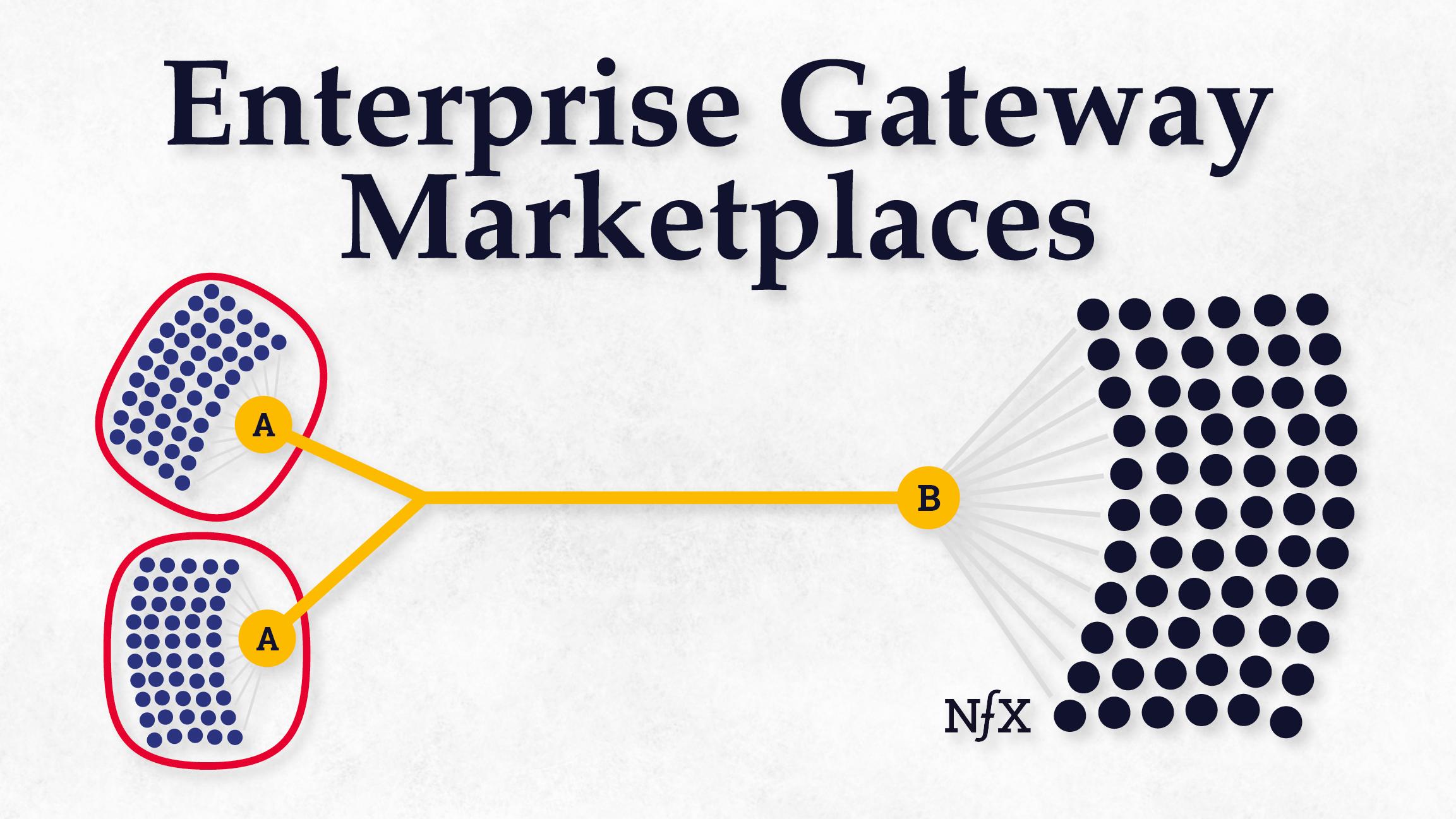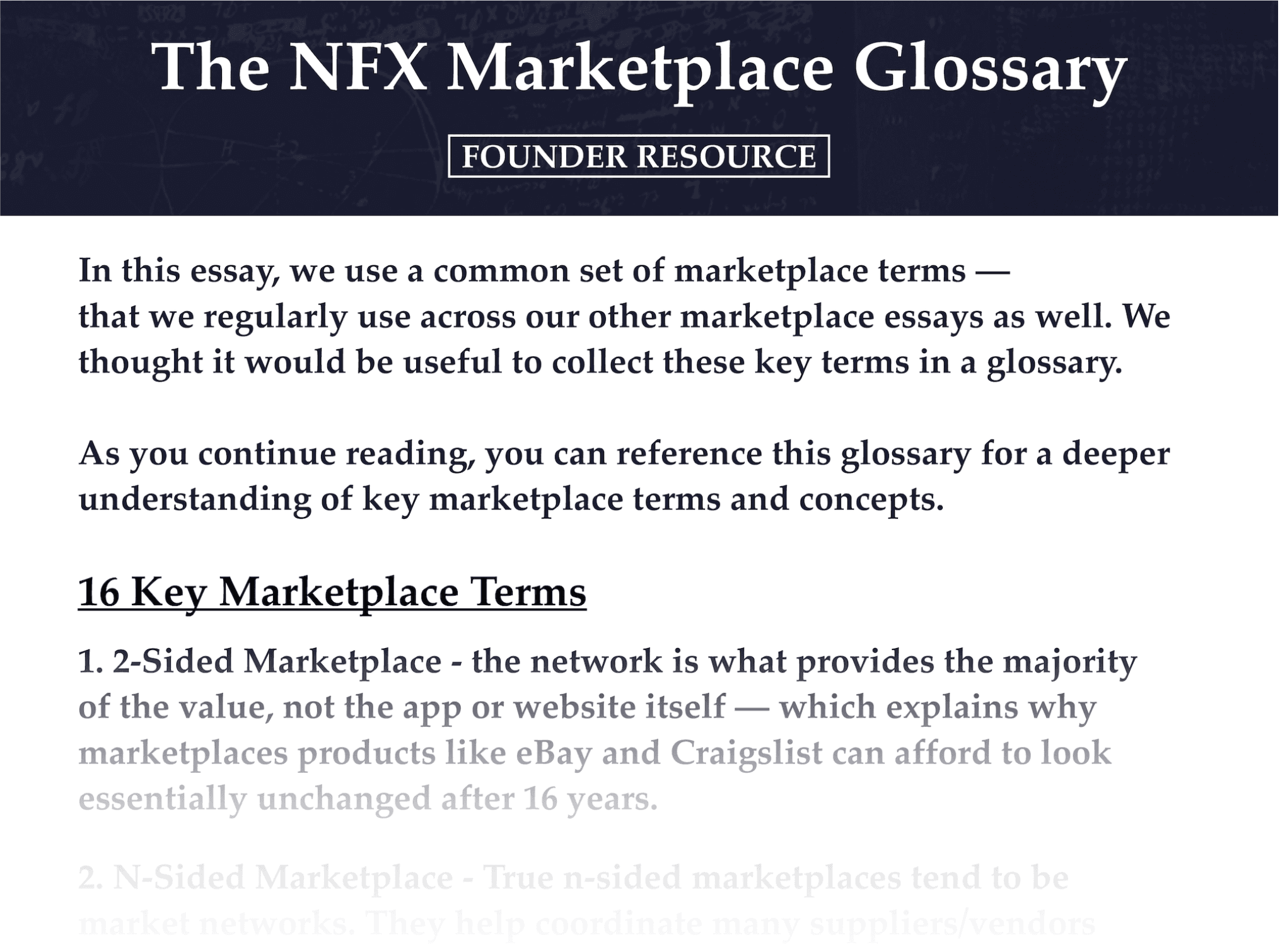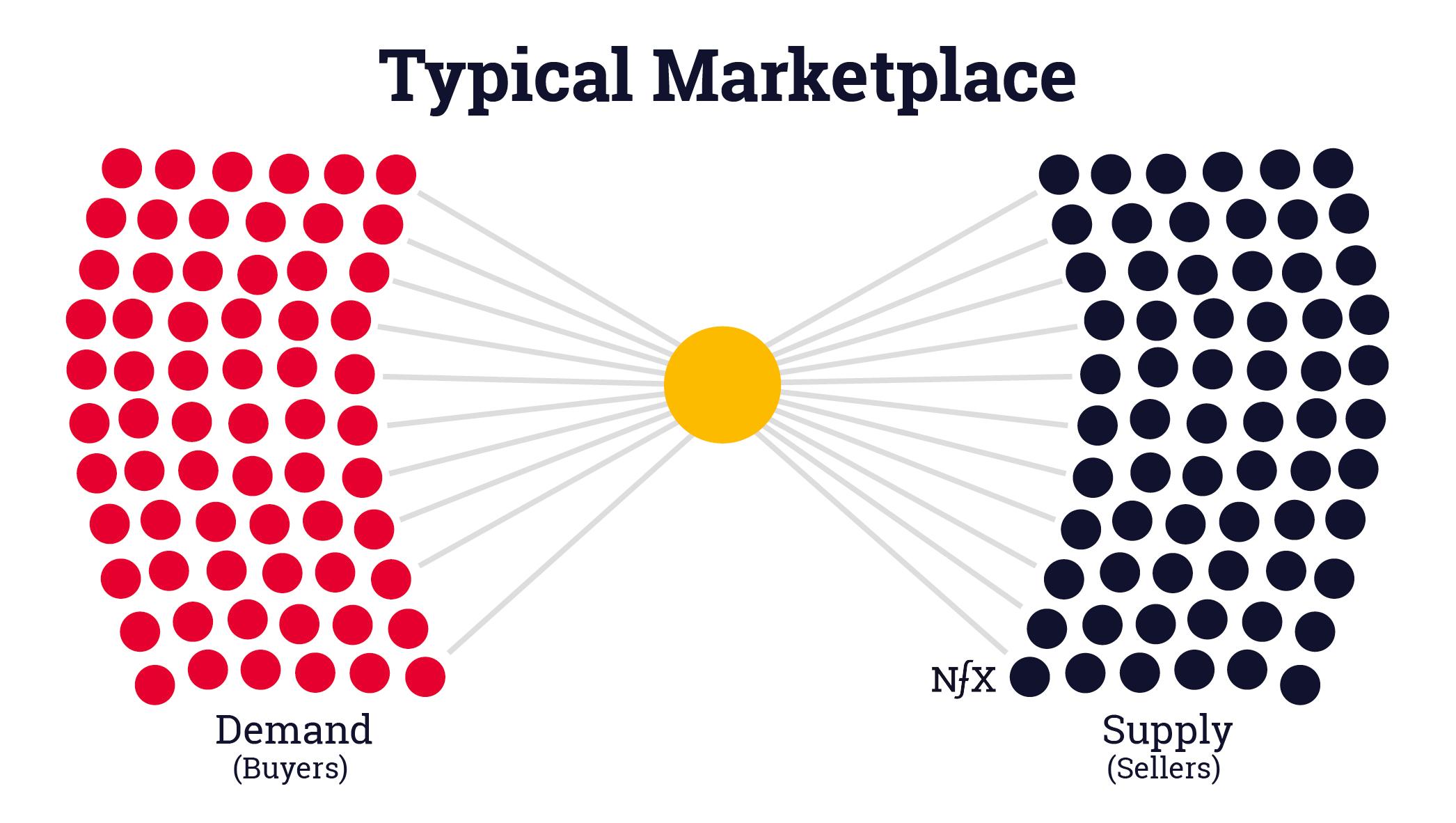

The marketplace revolution is still just beginning. As we’ve written before, there are many categories of marketplaces that are wide open for world-class Founders, including B2B, fintech-enabled marketplaces, media marketplaces, and market networks.
Here’s a new marketplace category: Enterprise Gateway Marketplaces (EGMs).
There is a white space opportunity for Founders in EGMs that combines SaaS embedding defensibility with the network effects defensibility of a marketplace.
What Is An Enterprise Gateway Marketplace?
EGMs are a variant on the traditional 2-sided marketplace model. They are marketplaces tailored to help big enterprises (2,000+ employees) on the demand side coordinate with 1,000s of outside vendors on the supply side. To do this, EGMs have to solve unique workflow and compliance challenges on both sides.
EGMs answer the question: “How can large, bureaucratic corporations add marketplace efficiencies?” EGMs help enterprise employees cut through internal red tape. They help employees get their jobs done better by giving them more possibilities about who to work with.
On the other side, the millions of smaller vendors, EGMs solve the challenge of selling into large corporations. This has always been difficult for small vendors, in part because of the separation between senior executives who traditionally needed to authorize contracts and the employees on the ground who directly use and benefit from their products.
EGMs get the blessing of the senior execs because they’re safe, adding to control and compliance, and EGMs get the blessing of the employees on the ground because they are flexible. This helps streamline buying from small vendors.
EGMs represent a new category of B2B SaaS.


For example, Candex* is a textbook EGM. It installs an approved data gateway inside Fortune 500 enterprises, letting the enterprise easily make <$150K payments to outside vendors. Enterprises pay Candex, and Candex pays the vendors. This allows the enterprise to increase spending control and compliance, while also allowing their employees to find and use the best external vendors, find the best prices, and minimize expensive and slow internal processes.


How EGMs Will Change The Corporation
EGMs have the potential to turn corporations inside out.
Let’s back up. Why do large corporations exist at all?
Corporations have been the most efficient structure to get stuff done. They are large network structures that, like nearly all networks, minimize transaction costs and work on the law of least resistance.
Traditionally, the networks formed inside a corporation have been denser, faster, and more valuable than networks forming outside the corporation. In short, the inner-facing corporate structure improved the network math on coordinated action, data sharing, improved decision-making, and speed.
But as we know, large corporate internal bureaucracy also obstructs network flow. It slows down decision-making, slows down action, and often drives what feels like bad decisions. As we’ve pointed out before, when networks grow too large they suffer from network congestion and pollution, which is why they get in their own way.
Now that we have the Internet and better ways of creating trust with people outside of an organization, it should be possible to make it faster/better/cheaper for nodes inside a corporation to link with outside nodes to complete certain tasks.
Imagine lower transaction costs with people outside than inside the corporation.
This Goes Well Beyond “Outsourcing”
In the past, enterprise outsourcing was done via large, complicated, high-cost, long-term, inflexible contracts with other sizable organizations. Big companies were comfortable working with other big companies.
But the EGM model can be 10X more flexible, 10X faster, and cheaper. EGMs are the approach we’ve seen that best unblocks the network pollution and makes it more efficient to go outside than rely on bringing things in-house.
An EGM is constantly adjusting and improving at low marginal cost — faster, we would argue, than a company can adjust and improve internally. The gap we see in 2021 will only get bigger over time.
It’s our prediction that large corporations will adopt the gig-economy and freelancer network-style operational approach adopted by SMBs over the last 8 years. EGMs are how large corporations will implement this shift.


EGMs are how large corporations will turn inside out in the next 20 years.
They will transform entire industries, or at least shift the balance of power between industry players. Those corporations that adopt EGMs early will more quickly take advantage of more of the new SaaS tools on the market, and benefit from innovation earlier in the adoption curve.
Solving these problems for enterprises solves one of their biggest competitive vulnerabilities. They also allow smaller companies to more easily find and sell to enterprise clients.
Examples of Enterprise Gateway Marketplaces
In addition to Candex, there are actually quite a few companies that have found their way to the EGM model. We began using the term “enterprise gateway marketplace” back in mid-2017 when we noticed the pattern. There are certainly other EGMs not yet on this list.
Jiff: EGM for healthcare services for employees of Fortune 500 companies. Jiff let HR departments of large corporations connect to a marketplace of outside vendors of healthcare and other benefits for their employees. Instead of a few heavy contracts, HR departments could use the Jiff “hub” marketplace to add or subtract the apps they wanted with the click of a button. This was a company I co-founded in 2011 that merged with Castlight Health in 2016.
Scientist.com connects large pharmaceutical companies and biotech firms with small laboratories, citizen scientists, and small biotech companies. Early on, the Founders realized they were something different from a normal B2B marketplace. They were calling themselves a B2E (business to enterprise) company to distinguish from other B2Bs.
But then they came across NFX’s early description of the EGM model on a podcast and recognized themselves in it. They politely asked if they could use the term and began to refer to themselves accordingly.
SmartRecruiters: for hiring solutions, enterprise recruiters get a marketplace for recruiting and hiring tools.
Proov.io: “Proof of Concept As A Service.” Innovation departments in large corporations use this EGM testing new software for internal use. A server inside the firewall of the company has been approved by IT, and all the new software to be tested can run from that server.
Guild Education: Upskilling, retraining, and continuing education. HR departments connect their employees to approved third-party learning partners.
Salesforce AppExchange: A Salesforce app marketplace launched in 2005 that turned the company from a pure CRM SaaS into an EGM for marketing technology and sales tech vendors.
You may not have heard a lot about EGMs like the ones listed above, but this trend is just beginning. Now that there are some examples, many others can move in to follow the success patterns.


Four Attributes Of A Successful EGM
1. EGMs have a Gateway, a single point of access for many buyers. As shown below, EGMs create a gateway to multiple potential buyers (demand-side nodes) within an enterprise instead of having the buyers and sellers linking directly to each other.




2. Getting inside, get approved. Like traditional SaaS, the EGM must figure out how to get through the myriad approvals required from IT, legal, finance, HR, procurement, etc. They must ensure compliance for taxes, payments, security, legal and/or HIPAA, etc. By getting all these approvals and maintaining many forms of compliance on an ongoing basis, the EGM removes the need for internal teams to work with their own people to get these things done for each decision. Can you hear them breathing that sigh of relief?
3. Create trust in supply through data. EGMs present updated data about each of the suppliers that helps build trust and lower friction to transactions. This is similar to most marketplaces but the key pieces of data can be different.
4. Help vendors comply. Software for the vendors must help them become fit to sell to the enterprise. Each enterprise might have different rules.
The Challenge (and Opportunity) of Building EGMs
So why are EGMs only now emerging?
Part of the reason is that they’re more difficult to build than traditional marketplaces.
The first wave of marketplace businesses went after the low-hanging fruit. But as we pointed out in Fintech-Enabled Marketplaces and B2B Marketplaces, the current wave of marketplace companies need to go after greater complexity — like EGMs.


For EGMs, the biggest area of difficulty is that you have 3 different types of stakeholders on the demand side who dictate product adoption, and come with different types of needs, incentives, and acquisition strategies:
1. Executive sponsors: senior people with decision-making ability.
2. Legal, compliance, procurement, and security: gatekeepers. You need to earn their trust before an enterprise will onboard to your platform.
3. Employee users: Your product has to be user-friendly and provide a lot of value to end-user employees, especially as SaaS adoption increasingly becomes bottom-up.


This means you have 3 types of demand-side users to cater to, instead of just one.
Further, even when you get the “sale” you still have to penetrate the account and get adoption. The deadly “second sale” is often harder to solve than the first sale. This is true in many SaaS companies but it’s particularly true with EGMs when your revenue is tied to usage, not just a monthly fee.
The positive thing is that once you solve the first and second sale for one large corporation, you often have enough demand to solve the chicken-or-egg problem and attract supply because the company should represent 100’s or 1,000’s or 10,000’s of buyers. This lets you methodically build toward critical mass and start benefiting from a network effect, which most SaaS companies can never do.
Plus, there is always opportunity in difficulty. The difficult “three stakeholders problem” can be seen as an opportunity because once EGMs start to scale, their combination of embedding and network effects makes them highly defensible.
The EGM Checklist: 6 Essential Tactics
Here are 6 tactics to increase your chances for success in building an EGM.
1. Generate Frequent Interactions
Give buyers reasons to be frequently active in the marketplace. Become part of their routines so you remain top of mind and they don’t forget you exist.
2. Learn How To Spread Inside The Organization
One division in one country might adopt you, but getting your solution to spread broadly inside companies is often a blocking point. Politics, suspicion, fiefdoms, re-certification by new compliance people… all of this can slow you down. Getting a first sale in EGMs is not the same as SaaS. There’s a lot of “second sale” and “customer success” that needs to happen after the first sale. Focus on the “expand” part of “land and expand.”
3. Design For Team Usage
Design your EGM to enable team usage. You can do this by encouraging group actions and/or notifications, making referrals to other team members part of the process, or reducing friction around communication.
4. Expand Enterprise Workflow Tools
Look for adjacent/horizontal opportunities to provide more workflow tools to your internal users. From your vantage point in the transaction, you might see things differently than other SaaS vendors.
5. Be a Complete Vertical Solution
EGMs should be a complete solution for whatever vertical you’re serving so that both sides of the marketplace know you’re the one-stop solution for their needs. This reduces the need or possibility of multi-tenanting on both sides of the marketplace.
6. Great Design
In the past, enterprise product adoption was top-down, so usability issues for employees were not front and center. But as adoption in large corporations increasingly trends bottom-up, enterprise products will look more and more like consumer products. Platforms that are ahead of the curve with this (e.g. Slack, Asana, and Twilio) will thrive.
EGMs Are the Next Phase of the Marketplace Revolution
Although few people see it right now, Enterprise Gateway Marketplaces are going to be a big part of the ongoing marketplace revolution.
They make it manageable for small vendors to sell into S&P 500 customers that are normally out of reach and make it easier for enterprises to work with outside vendors to get the latest business products and services without having to bring them in-house.
World-class Founders who can see the need for EGMs and have the vision to execute will form part of the next generation of iconic marketplaces that rewrite entire industries.
*Candex is an NFX portfolio company


As Founders ourselves, we respect your time. That’s why we built BriefLink, a new software tool that minimizes the upfront time of getting the VC meeting. Simply tell us about your company in 9 easy questions, and you’ll hear from us if it’s a fit.
